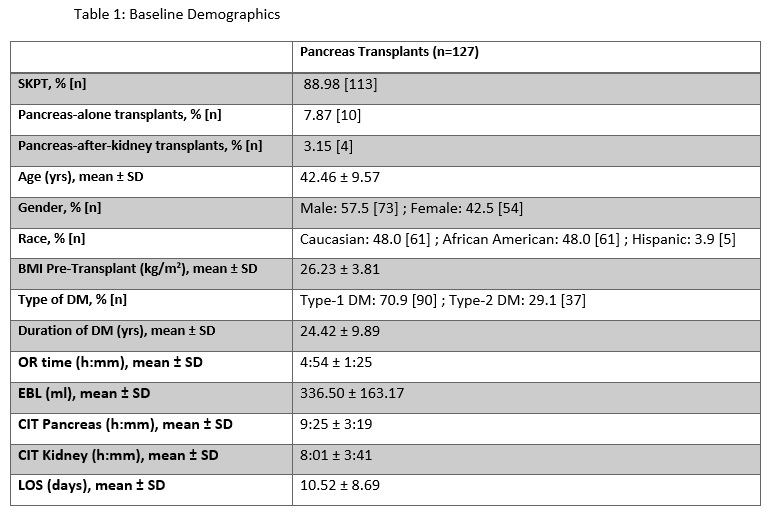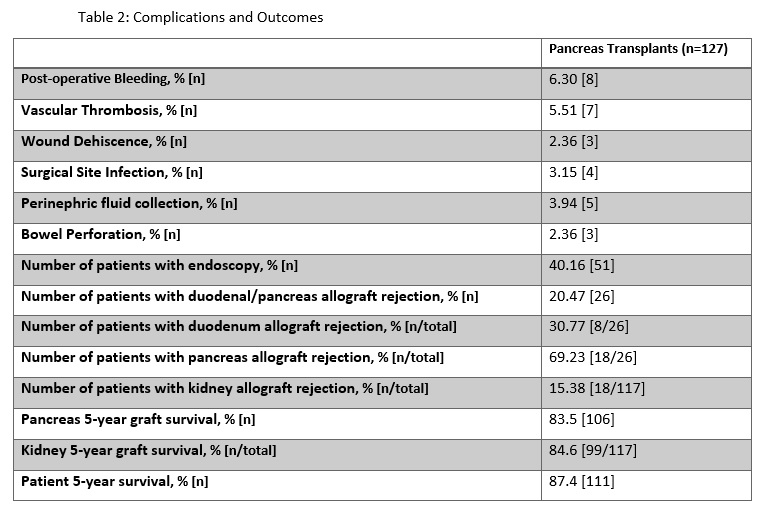Portal-Endocrine and Gastric-Exocrine Drainage Technique in Pancreatic Transplantation
1John C. McDonald Regional Transplant Center - Willis Knighton Health System, Shreveport, LA, 2Transplant, John C. McDonald Regional Transplant Center - Willis Knighton Health System, Shreveport, LA
Meeting: 2022 American Transplant Congress
Abstract number: 1152
Keywords: Kidney/pancreas transplantation, Outcome, Pancreas transplantation, Surgical complications
Topic: Clinical Science » Pancreas » 65 - Pancreas and Islet: All Topics
Session Information
Session Name: Pancreas and Islet: All Topics
Session Type: Poster Abstract
Date: Sunday, June 5, 2022
Session Time: 7:00pm-8:00pm
 Presentation Time: 7:00pm-8:00pm
Presentation Time: 7:00pm-8:00pm
Location: Hynes Halls C & D
*Purpose: Diagnosis of rejection has continued to be problematic in pancreas transplantation (PT). In 2007, we innovated a new surgical technique for PT, portal-endocrine and gastric exocrine drainage (P-G) technique, where the end of allograft jejunum was anastomosed to the anterior aspect of the stomach, facilitating endoscopic access to duodenum/pancreas allograft. The aim of our study was to evaluate the safety, measure allograft rejection, and calculate graft and patient survival in patients who underwent PT with the P-G technique.
*Methods: This was a retrospective review study of 127 PT patients with P-G technique from Sep 2007 to Jul 2021 at our center. 113 simultaneous kidney-pancreas transplants (SKPT), 10 pancreas-alone transplants, and 4 pancreas-after-kidney transplants were performed. Baseline demographics, OR time, estimated blood loss (EBL), cold ischemic time (CIT) for kidney and pancreas allografts, length of hospital stay (LOS), complications, number of patients with endoscopy, number of patients with allograft rejection, death-censored 5-year kidney and pancreas graft survival, and 5-year patient survival were calculated.
*Results: Table 1 summarizes baseline demographics and Table 2 highlights complications and outcomes. Perioperative complications included 8 post-operative bleed and 7 vascular thrombosis. Patients with vascular thrombosis had subsequent transplant pancreatectomies within 6 weeks. During the study period, 51 transplant patients underwent upper GI endoscopy. Duodenum/pancreas allograft rejection was found in 26 patients. The death-censored 5-year graft survival for pancreas and kidney were 83.5 % and 84.6 %, respectively. Patient survival was 87.4%.
*Conclusions: This P-G drainage technique for PT has proven to be safe with good graft and patient outcomes. Access to donor duodenum and pancreas allograft via endoscopy is unique to this technique and provides the added advantage of life-long easy access to the allograft.
To cite this abstract in AMA style:
Shokouh-Amiri H, Naseer MS, McMillan R, Aultman D, Tandukar S, Singh N, Zibari GB. Portal-Endocrine and Gastric-Exocrine Drainage Technique in Pancreatic Transplantation [abstract]. Am J Transplant. 2022; 22 (suppl 3). https://atcmeetingabstracts.com/abstract/portal-endocrine-and-gastric-exocrine-drainage-technique-in-pancreatic-transplantation-2/. Accessed December 17, 2025.« Back to 2022 American Transplant Congress


